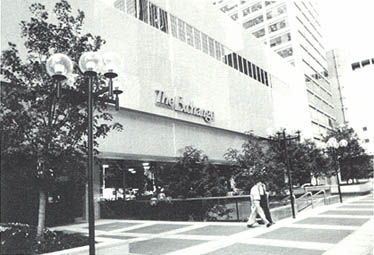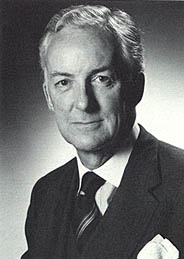  |
| 1. The Toronto Stock Exchange Tower, Home of Canada's Largest Stock Exchange. 2. J. Pearce Bunting, President and Chief Executive Officer, The Toronto Stock Exchange. |
The Toronto Stock Exchange is Canada's largest stock exchange and one of the world's top ten in size. Over 75% of the dollar value of all shares traded in Canada is completed on the trading floor of the TSE. Orders from across the country and around the world flow into this industrial and resource-based exchange, both for equities and options.
The Toronto Stock Exchange, as Canada's premier exchange, is important to the health of the Canadian economy. It is the central marketplace where companies can raise capital to grow and develop, providing more products and services and more jobs for Canadians.
The Toronto Stock Exchange began as an association of 12 businessmen in 1852. These men met daily to buy and sell securities. In 1878 The Exchange was formally incorporated by a special Act of the Ontario Legislature. The TSE moved to its first permanent trading headquarters in 1881. Not many years later TSE stock data was transmitted internationally via cable to London, England, where it was published regularly.
The year 1934 marked the amalgamation of the TSE and its competition, the Standard Stock and Mining Exchange. Three years later, in 1937, The Toronto Stock Exchange moved to a new building at 234 Bay Street. Heralded as an ultra-modern trading facility, it utilized the most advanced electronic trading technology and equipment. Modern in every sense, this location was one of the city's first air-conditioned buildings.
The Toronto market boomed during the 1950's. The TSE topped all other exchanges in North America in volume of shares traded. With market prosperity came the need for tighter regulatory control. In 1958 TSE-listed companies were required to disclose any corporate changes affecting the price of their shares. In 1965 the TSE established the Market Surveillance Department to enforce more stringent disclosure policies for listed companies. It was the first Canadian stock exchange to do so.
The 1970's were years of technological development and advancement for The Exchange. The CANDAT market information service was established, evolving through several stages. The Computer Assisted Trading System (CATS) was launched experimentally with 30 stocks. This continued growth of The Toronto Stock Exchange meant larger, more efficient trading facilities were needed. In May, 1983, The Exchange moved from its 234 Bay Street location into what was once again described as "ultra-modern" facilities on Adelaide Street. The move was a significant step in the TSE's evolution. The new trading floor and advanced trading systems now make the TSE a world leader in stock exchange technology.
The Toronto Stock Exchange is a not-for-profit institution owned and operated by its Member brokerage firms. Much of The Exchange's revenue is acquired through fees paid by the Member firms. Public companies pay fees to have their shares listed for trading, then pay an annual sustaining fee to The Exchange. Revenue is also derived from selling TSE products, such as computer services and information.
A 13-member Board of Governors directs the operation of The Exchange. Five Governors are elected annually from The Exchange's Membership and serve for a twoyear term without remuneration. Two Public Governors are appointed from business outside the investment community. The Governors elect one of their numbers to act as Chairman of the Board. The President of The Exchange is also a member of the Board.
  |
| 1. The Toronto Stock Exchange Tower, Home of Canada's Largest Stock Exchange. 2. J. Pearce Bunting, President and Chief Executive Officer, The Toronto Stock Exchange. |
The executive staff, headed by the President, is responsible for the administration of The Exchange and for carrying out the policies established by the Board. The President is a full-time employee of The Exchange. The TSE employs about 400 people in various capacities from administration to technical.
Approximately seventy-five brokerage firms comprise the membership of The Toronto Stock Exchange. To become a Member of the TSE the firm must purchase a seat or membership. This entitles the firms to use the facilities of The Exchange to conduct the business of buying and selling securities. The cost to purchase a membership has varied substantially since the early days of the TSE when it was common to buy a seat for $6.00. Recent seat sales have been for over $360,000. All 131 seats are currently owned. Five additional seats are held in treasury.
Through the years The Toronto Stock Exchange has earned a reputation as a leader in trading and information systems technology. Innovation has been key to this development at The Exchange. The Computer Assisted Trading System, or CATS as it is called, is a prime example of this technological leadership. Developed by The Exchange in 1977, it is the world's first computerized trading system. Nearly half of all TSE listed stocks are traded exclusively through CATS. There are now over 400 terminals accessing CATS.
With the installation of two terminals which began trading from London, England, CATS became a truly international system. In 1985 the Paris Stock Exchange leased CATS on a long-term contract, providing that exchange with an efficient and reliable continuous trading market and stock quotation system. The Brussels Stock Exchange also leased the CATS system in late 1987. Negotiations are underway for similar arrangements with other exchanges.
The Exchange's major market indicator is the TSE 300 Composite Index. In addition, the High-Technology Index, launched by the TSE in early 1985, provides investors with an indicator of how high-technology stocks are performing in the marketplace. In the Spring of 1987 the TSE
launched another new index called the Toronto 35. It tracks the performance of 35 Canadian blue chip stocks. This new index was created for the purpose of trading derivative products specifically designed to meet the trading and hedging needs of investors and fund managers. It also allows institutional investors to implement new trading strategies.
The Toronto Stock Exchange is a participating member of the International Federation of Stock Exchanges which represents principal stock exchanges around the world. The main objectives of the Federation are to foster equal rights of all shareholders and to co-ordinate the structures of securities markets.
Mr. J. Pearce Bunting, President and Chief Executive Officer of The Toronto Stock Exchange, completed a two-year term as President of the FIBV in December, 1984. It was the first time in the TSE's 22-year membership in the Federation that a Canadian held this post.
As a self-regulating organization operating under the authority of the Ontario Securities Commission, The Toronto Stock Exchange has a responsibility to provide a fair and open marketplace where Canadians can confidently buy or sell shares. The Canadian public can also look to the TSE for efficient service and the very best prices for Canadian shares in North America.